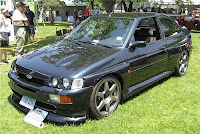Most non-US cars that are imported here are 25 years old or older because that’s the point at which any foreign road car becomes exempt from all EPA and DOT requirements. The importer just has to pay some relatively small fees and duties, as well as the less-than-you-may-think shipping cost, and that’s about it. The cost of these cars usually isn’t drastically higher than what they’d cost in their home market.
Cars less than 25 years old, however, have to be modified to comply with federal safety standards, and those less than 21 years old must meet the emissions requirements as well. There is a list that the DOT publishes online that includes all the vehicles already determined eligible for safety conversion, but if a foreign car isn’t on the list then a Registered Importer has to petition them to allow it to import and convert the car. Assuming that there is a “substantially similar” car already for sale in the US, the process isn’t too bad from there on out. Where it gets really expensive is if the car is totally unique to rest-of-the-world markets.Cars like the Escort Cosworth, Skyline GT-R, Citroën XM, pre-2002 Geländewagen, and pre-2008 Smart ForTwo have no similar models sold in the U.S. When registered importers decided they wanted to bring the first ones over, they had to gain permission to try and come up with a way to modify them so they meet safety and emission standards, which includes crash testing the cars. If the results are successful, the car is put on the DOT’s eligible cars list and subsequent cars can be imported and modified in the approved manner. Because the process of crash testing is extremely expensive, registered importers can patent their resulting safety modifications so that they have de facto exclusive rights to import that car, allowing them to name their price in order to recoup the high initial cost. This resulting high conversion cost means that only the most significant or demanded foreign cars are put through the process, and registered importers (or the customers who contract them) have to make sure it’s worth the gamble. When G&K started importing 2004-2006 Smart ForTwo’s, they needed to ensure that there was sufficient demand for the cars in the US, and they imported 1,000 of them to spread the cost out enough to sell them for a reasonable price (though as per the EPA’s rules the cars first had to be titled in the US and sold as used).
Most cars just aren't significant enough to warrant the expense. It’s unlikely anyone will start independently importing the Dacia Sandero any time soon. But is a Ford Escort RS Cosworth worth $30,000? Is a Smart? On the face of it, probably not, but the cost to import one to the US may be higher than you think, and as Richard commented, “it’s the premium you pay to drive something unique.”
More information about DOT and EPA requirements for importation of foreign cars can be found here:




Interesting website; looking forward to more posts. Have to say that I saw a Porsche 959 on I-55 leaving Chicago on Saturday. Never seen one in real life and wasn't aware any were legal to drive in the US...
ReplyDeleteTimothy, that's definitely a rare sight on the road. I didn't go into this in the post, but there is another way that some very significant (and usually expensive) cars are imported called "Show and Display." It was enacted in 1999, and allows vehicles of "technological or historical significance" to be imported without safety modifications and crash testing, but they're limited to 2,500 miles per year of driving. I'll go into greater detail in another post soon. Thanks for the comment!
ReplyDelete